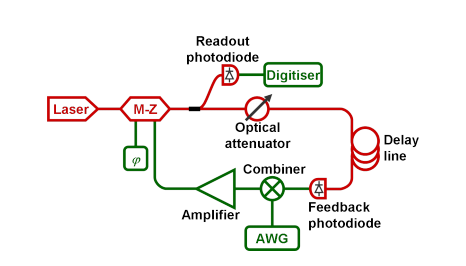First demonstration of optoelectronic reservoir computing
December 5, 2011
Researchers at the Universite Libre de Bruxelles in Belgium have revealed the first incarnation of an exotic new form of computing called “reservoir computing” that exploits feedback mechanisms to perform impressively fast analog calculations, Technology Review Physics arXiv Blog reports.
The feedback loop is a kind of memory that stores information about the system’s recent history. So this kind processing acts on small segment of the recent past. Many grand challenges in computing, such as speech recognition, depend on processing information from a small window in the recent past.
Here the reservoir consists of a reasonably large number of nodes that are connected together at random, using optoelectronic components. Each node is some kind of nonlinear feedback loop. The input, or inputs, are fed into random nodes in the reservoir and the output, or outputs, taken from other randomly chosen nodes.
The system is then trained to produce the desired computation by weighting the outputs in a certain way. For example, the input might consist of a waves of certain shapes and the output would be an indication that specific shapes had been recognized. Only the output signals are weighted during training, making this process much simpler than with a neural network, which are notoriously difficult to fine tune.
Ref.: Yvan Paquot et al., Optoelectronic Reservoir Computing, arxiv.org/abs/1111.7219
